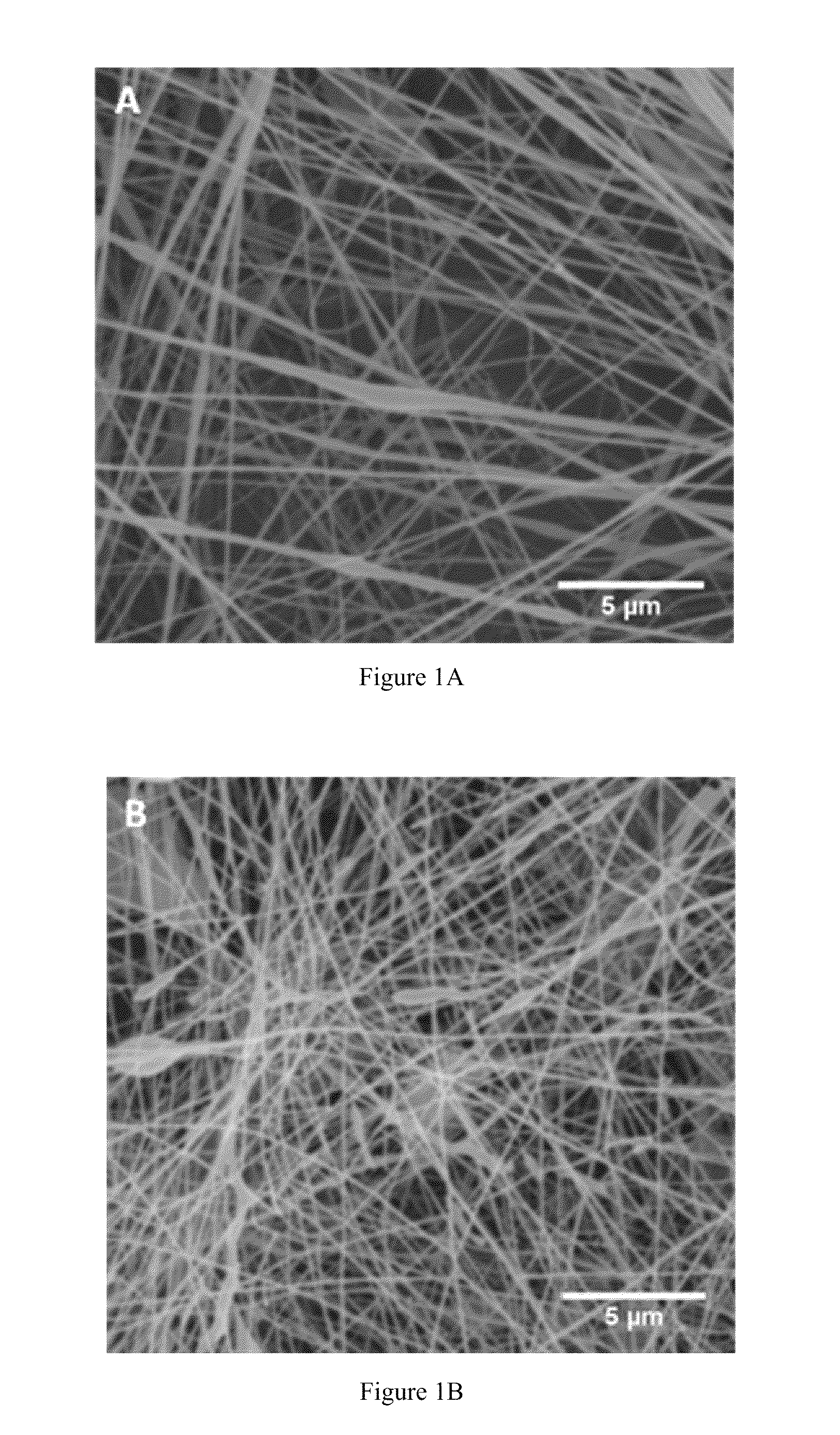Compositions and methods for making and using laminin nanofibers
a technology of laminin nanofibers and nanofibers, which is applied in the field of compositions, can solve the problems of prohibitive three-dimensional scaffolding and high cost of laminin and reconstituted basement membrane manufacture, and achieve novel biomimetic effects, long shelf life, and greater tensile strength
- Summary
- Abstract
- Description
- Claims
- Application Information
AI Technical Summary
Benefits of technology
Problems solved by technology
Method used
Image
Examples
example 1
[0319]Materials and Methods—
[0320]The solvent, 1,1,1,3,3,3-hexafluoro-2-propanol (HFP) was purchased from Sigma (St Louis, Mo.). All cell culture reagents were purchased from Fisher Scientific (Pittsburgh, Pa.).
[0321]Laminin Isolation
[0322]Laminin I was purified from the EHS tumor according to previously established methods. The final laminin solution was subjected to 2 rounds of precipitation with 45% ammonium sulfate to remove most growth factors present. Purity of laminin was evaluated by SDS-PAGE and Western analysis with affinity purified antibodies to type IV collagen, entactin / nidogen and perlecan, the major contaminants of such preparations. Purity was determined to be greater than 99% laminin (w / v). Laminin was stored at −80° C.
[0323]Laminin Electrospinning
[0324]For the parametric study, a series of process parameters was chosen within ranges shown to be successful in creating submicron or nanoscale fibers of other ECM proteins such as collagens [13] and fibrinogen. Laminin...
example 2
Laminin Nanofiber Mesh Substrates for Stem Cell Growth and Differentiation as Recited in U.S. application Ser. No. 12 / 598,776.
[0358]Methods—Embryonic Stem Cell Culture: D3 and ES-E14TG2a murine embryonic stem cells were cultured on STO or CF1 mouse embryonic fibroblast feeder layers, fed daily and sub-cultured every 2 or 3 days. The media used was DMEM+15% ES-qualified FBS supplemented with L-glutamine, non essential amino acids, pyruvate, 2-mercaptoethanol, and leukemia inhibitory factor (Chemicon). All tissue culture reagents were from GIBCO except as noted.
[0359]Fabricated meshes of laminin I nanofibers (LNFs) with fiber size (10-150 nM dia.), geometry, and porosity of authentic basement membranes were fabricated using electrospinning methods. Unlike previously described NFs synthesized from protein polymers, meshes of LNFs retain their structural features when wetted and do not require fixation by chemical cross-linking, which often destroys biological activity. Embryonic stem c...
example 3
[0360]The following includes the new material upon which the present application is based, relative to the application for which it claims priority as a CIP application, i.e., U.S. patent application Ser. No. 12 / 598,776, filed Nov. 4, 2009.
[0361]Materials and Methods
[0362]All cell culture reagents were purchased from Invitrogen (Gibco) unless otherwise noted. Solvents for electrospinning were purchased from Sigma-Aldrich (St. Louis, Mo.), as was polycaprolactone, Mn 70-90 kDa by GPC. Laminin was isolated and purified from the Englebreth-Holm-Swarm (EHS) murine tumor in our laboratory as previously described [7].
[0363]Cell Culture
[0364]PC12 cells were obtained from ATCC and maintained in at 5% CO2 in normal growth medium consisting of DMEM / F12 (1:1) supplemented with 10% horse serum, 5% fetal bovine serum (FBS), and 1% penicillin-streptomycin. Medium was renewed every 2-3 days as needed, and cells were passaged when cell density approached 2×105 cells / cm2. To assess cell attachment o...
PUM
| Property | Measurement | Unit |
|---|---|---|
| diameters | aaaaa | aaaaa |
| diameters | aaaaa | aaaaa |
| gap distance | aaaaa | aaaaa |
Abstract
Description
Claims
Application Information
 Login to View More
Login to View More - R&D
- Intellectual Property
- Life Sciences
- Materials
- Tech Scout
- Unparalleled Data Quality
- Higher Quality Content
- 60% Fewer Hallucinations
Browse by: Latest US Patents, China's latest patents, Technical Efficacy Thesaurus, Application Domain, Technology Topic, Popular Technical Reports.
© 2025 PatSnap. All rights reserved.Legal|Privacy policy|Modern Slavery Act Transparency Statement|Sitemap|About US| Contact US: help@patsnap.com



